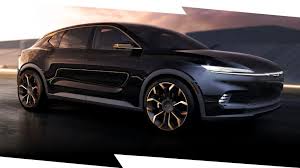In a surprising move, Chrysler has reportedly paused its electric crossover program, leaving industry experts and consumers alike speculating about the reasons and implications. As one of the legacy automakers striving to carve a niche in the increasingly competitive electric vehicle (EV) market, this decision raises several questions about Chrysler’s strategy and the broader challenges in the EV sector.
The program’s suspension comes at a time when automakers are racing to meet the growing demand for EVs, fueled by global environmental regulations and shifting consumer preferences. While the specifics behind Chrysler’s decision remain unclear, it’s essential to explore the potential factors contributing to this pause and what it could mean for the future of the brand’s electrification efforts.
Understanding Chrysler’s Position in the EV Market

Chrysler, a brand under the Stellantis umbrella, has historically been associated with dependable sedans and minivans rather than cutting-edge electric technology. However, in recent years, the automaker has pledged to transition towards a more sustainable and electrified lineup. The reported pause in the electric crossover program may indicate a need to reassess their EV strategy amid a rapidly evolving landscape.
The company’s competitors, including Tesla, Ford, and General Motors, have made significant strides in launching electric crossovers and SUVs, often hailed as the “sweet spot” for EV adoption due to their popularity among consumers. Chrysler’s decision to pause could be attributed to challenges such as supply chain constraints, technological hurdles, or even shifts in consumer demand.
The Role of Supply Chain and Production Challenges
Supply chain disruptions have become a recurring theme in the automotive industry, and the EV sector is no exception. The global semiconductor shortage, coupled with the increasing demand for critical battery materials like lithium and cobalt, has made it challenging for automakers to scale production. These factors could have played a significant role in Chrysler’s decision to delay its electric crossover program.
Additionally, the cost of EV production remains a significant barrier for many manufacturers. Developing an electric crossover involves substantial investment in research, development, and manufacturing infrastructure. Chrysler may have decided to pause and reallocate resources to ensure a more robust launch when conditions are more favorable.
Consumer Trends and Market Dynamics
Another potential reason for the program’s pause could be a shift in consumer preferences or market trends. While demand for EVs is on the rise, the market is still relatively young, and consumer expectations are evolving rapidly. Chrysler might be taking a step back to better understand these dynamics and refine its product offering.
Furthermore, pricing remains a critical factor in EV adoption. If Chrysler’s electric crossover is positioned at a higher price point than competitors, it could struggle to gain traction. By pausing the program, the company may aim to adjust its pricing strategy or explore ways to reduce production costs.
Implications for Chrysler and the EV Industry

The decision to pause the electric crossover program highlights the complexities of transitioning to electric mobility. For Chrysler, this move could be seen as a setback, but it also presents an opportunity to regroup and strategize for a more successful entry into the EV market.
For the broader industry, Chrysler’s pause serves as a reminder of the challenges automakers face in navigating this transition. It underscores the importance of innovation, adaptability, and strategic planning in meeting the demands of a rapidly changing market.
As the EV landscape continues to evolve, it will be interesting to see how Chrysler and other legacy automakers adapt their strategies to remain competitive. While this pause may delay Chrysler’s electrification goals, it also provides an opportunity to refine their approach and ultimately deliver a product that meets consumer expectations and market demands.
A Pause, Not an End
Chrysler’s decision to halt its electric crossover program might be disappointing to some, but it’s essential to view it as a strategic pause rather than an end. The EV market is complex and dynamic, requiring automakers to remain flexible and responsive to challenges and opportunities.
As consumers and industry observers, it’s crucial to watch how Chrysler navigates this pause and whether it will emerge stronger with a more competitive and innovative product. The road to electrification is rarely smooth, but with careful planning and execution, Chrysler has the potential to make a significant impact in the EV market.

